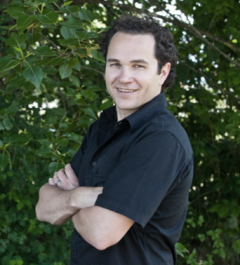Speaker: Andy Gassner
Date: January 25th, 2021
 Andy Gassner is passionate about creating technology that enables a sustainable energy future. With a background in Physics and Astrophysics, he helped create the world’s largest Neutrino telescope in Antarctica. His focus has shifted from the cosmos to building products for a smarter electrical grid, harnessing the flexibility from distributed energy resources to displace carbon power sources. Andy has over a decade of experience in the distributed energy space, spanning regulatory policy in wholesale markets to product management, where he’s currently focused on managing Enbalaʼs distributed energy resource management system and virtual power plant product suite in North America. Andy holds a Master of Applied Science degree through the Institute of Integrated Energy Systems at the University of Victoria.
Andy Gassner is passionate about creating technology that enables a sustainable energy future. With a background in Physics and Astrophysics, he helped create the world’s largest Neutrino telescope in Antarctica. His focus has shifted from the cosmos to building products for a smarter electrical grid, harnessing the flexibility from distributed energy resources to displace carbon power sources. Andy has over a decade of experience in the distributed energy space, spanning regulatory policy in wholesale markets to product management, where he’s currently focused on managing Enbalaʼs distributed energy resource management system and virtual power plant product suite in North America. Andy holds a Master of Applied Science degree through the Institute of Integrated Energy Systems at the University of Victoria.
Presentation
Founded in 2003, Enbala is a US-owned company focused on distributed energy resources. They manage technologies such as solar, energy storage, electric vehicles, and smart thermostats; controlling distributed energy resources to best utilize existing assets and thus further decarbonize the power supply.
Mr. Gassner discussed what he referred to as “the grid 2.0”: a revolution that is happening within the power system as distributed energy resources become increasingly common. This revolution is defined by both opportunities and challenges. In terms of opportunities, these distributed energy resources provide an opportunity to put more renewable and carbon-free generation on the grid. Distributed and local generation also avoids the efficiency losses of transmitting power across vast distances. Lastly, distributed generation can help in terms of resiliency and climate change adaptation. For example, in California during wildfire season utilities have controlled blackouts to avoid causing fires in the increasingly hotter and dryer landscape. These utilities are looking to provide customers with distributed energy assets as a solution, to provide them with islands of self-sustaining power which can operate through blackout periods.
However, the existing power grid was simply not designed to have intermittent power sources and power sources at the grid edge. Instead, the current grid structure focuses on a central generation facility pushing power out to homes and buildings. Increased distributed energy generation flips this structure on its head, and instead promotes local and smaller-scale power generation. This causes problems in the grid, including complications stemming from reverse power flows, voltage issues, and elevated costs. This leads to difficulties for utilities, who may be forced to cap how much distributed energy assets they have installed or put constraints on the resources that someone needs to manage.
Beyond these technological barriers, distributed generation also face social, policy, and business challenges. In terms of social challenges, the elevated costs related to this grid revolution raises concerns regarding equity: who bears the cost? This brings in concerns such as energy poverty. In terms of policy and business challenges, despite progress, a lack of definitive rules and regulations surrounding these issues have made it difficult to attract investors and scale the solution.
Despite challenges, there is a global trend towards distributed energy generation. This trend can be seen across North America, Brazil, Europe, Australia, Japan, and Dubai. Actors from around the globe are increasingly trying to overcome these challenges associated with distributed generation and find solutions to create a more sustainable energy future. Enbala is one such actor, working to facilitate the further penetration of these technologies.
To better explain what Enbala does, Mr. Gassner brought up the idea of a virtual power plant (VPP). Flipping the traditional centralized grid structure on its head and spreading generation out means that you need to make the system ‘smart’ enough to manage generation and distribution in a virtual and localized setting. This is what Enbala does, it manages these scattered and distributed assets and brings them together, not to a physical premise, but virtually. Mr. Gassner reviewed how exactly this works and how a VPP is operated. In a traditional utility system, a power dispatcher is responsible for ensuring that generation meets demand. In order to do this, they use load forecasts to schedule generation ahead of time and they monitor the real-time system for any unexpected events. Enbala and its VPP is one of the resources that this power dispatcher would call on to either increase generation or curtail load and thus ensure that the system stays in balance. Enbala’s software is responsible for taking that request and determining which assets to use and how (e.g., which batteries are the best to charge? are they full? empty?). Enbala’s mission is to create a sustainable energy future. With two offices, one in Denver and one in Vancouver, they are currently controlling 15,000 distributed energy resources with their software platform.
But how much impact is this really having on mitigating climate change? Electricity production is responsible for approximately 25% of GHG emissions, meaning that distributed energy resources present a valuable opportunity for climate change mitigation. Despite notable progress on this front, many of the challenges previously discussed still require solutions, specifically solutions which cut through a variety of disciplines and thus require input from people of all walks of life and backgrounds. While recognizing the contribution that this technology can make, Mr. Gassner emphasized that technology is not a silver bullet. Rather, it will take a slew of different solutions in order to achieve decarbonization and a sustainable energy future.
Discussion
Q: Are people are starting to produce power in a distributed way from all different households, say with solar PV or by other means? We also have this old infrastructure in place which requires tremendous investment. So is that the biggest challenge or the biggest barrier to distributed generation? and is there thought put into this for the future?
A: Yes. A lot of the business cases are based on deferral of infrastructure. So let’s say I have a substation that I want to upgrade because of X, Y, and Z. If you can just defer that for a few years, because you’re being smarter about controlling or managing those assets underneath that substation, you can justify a business case to the utility. More utilities are coming around to this. And they’re increasingly purchasing distributed energy resource management systems. So it’s the software system that allows them to manage those assets to the point where you can alleviate many of issues that you’re seeing.
Q: What is complex load?
A: Really anything that is controllable, something that you can shift or you can operate remotely.
Q: What are load forecasts based on and how do they deal with uncertainty?
A: Utilities typically have their own load planning department, so they’ll have people who specialize in that. Load forecasts in a very general sense are built off of historical data and then they’ll correlate those to other outside factors like temperature, so they can get pretty complex. And we’ve built our own tools to help utilities, like machine learning type of algorithms. But mostly what they’re looking at is historical system demand profiles and then correlating those with external factors and with machine learning (which are getting smarter and smarter). For example, if there’s a big hockey game on, they know that loads are going to go up.
Q: Some of the technologies you manage, such as electric vehicles, are quite new so it may be hard to manage them based on historical experiences. So is the system updating itself and working to understand what’s happening in new systems that we don’t know much about?
A: Yes, that’s right. And actually one of the big challenges is with solar, they don’t have measurement on rooftop solar. So what ends up happening is it just looks like there’s less overall system load when the sun is shining since the only thing that the utility really has is a load profile. But then all of a sudden, a cloud passes and all that load comes back onto the system because the solar PV is not generating. I would say that for most utilities, the number one challenge for them with distributed energy is trying to get data. It’s something that they’re working towards but they’ve never had to do it on such a large scale. And this brings further complications like cyber security and communications issues.
Q: How is value assigned for a unit of power when it comes to grid management load shifting capabilities?
A: It’s hard because it’s tied to the value that you’re delivering per kilowatt hour and that calculation is different for every jurisdiction because their varied fuel and energy make-up. For example, BC and Quebec don’t value flexibility all that much because they have endless hydro, making this technology harder to justify. But if you go to Australia, energy is expensive and so it’s really easy to justify this technology simply because of where you are. So there’s no easy answer to this, and really this is a big part of what we do. We look at what the value of Enbala technology would be to the utility through tying it back to more of a systems analysis of what we would be displacing.
Q: Where is Enbala deployed and how can it be implemented in developing nations?
A: India and China are obviously two huge markets, but we have not had a lot of traction there. What we’re doing is chasing more larger-scale projects, so the problem we run into in many developing nations is that it’s hard to justify a smaller project because of high upfront fixed costs, making the payback quite bad. So a lot of the stuff that we do is in established markets. A lot of activity on this is happening in developing countries, we simply don’t have presence there yet.
Precis completed by Silke Popescu, MA Sustainable Energy student.
Learn more about Enbala’s work in their white paper “Ringing in the new: Powering through to a clean energy future” or on Enbala’s website.
